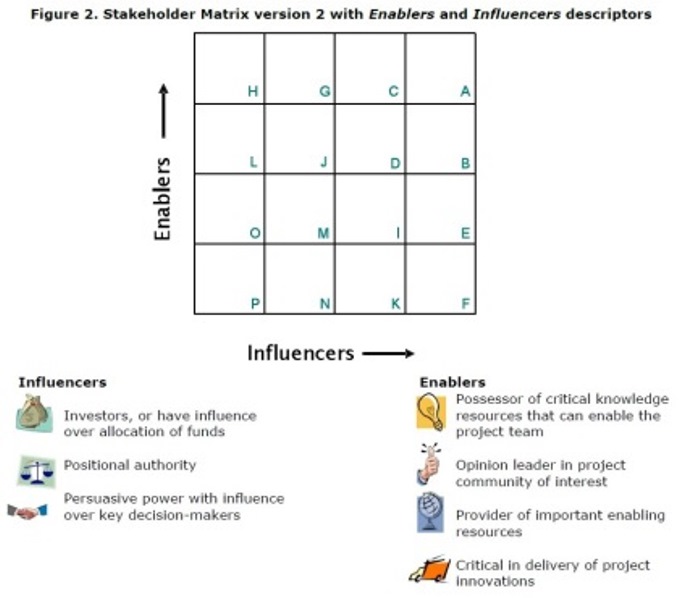Stakeholder analysis is an important initial step in project work as it is a process that can provide insights into and an understanding of the interactions between a project and its stakeholders. This tool can identify and prioritise which stakeholders can have impact on the project’s success and is often the first step in project planning. It is also important for developing engagement strategies for building and maintaining the networks necessary to achieve project outcomes. It makes for a clearer understanding of the range and roles of project stakeholders.
The tool is a revised stakeholder analysis tool to systematically or strategically asses the human and social capital resources required to deliver projects and to address gaps typically found in stakeholder analyses, which have tended to focus on the target population for projects.
It was developed by people working in the Practice Change Capacity Development (PCCD) unit of the Victorian Department of Primary Industries in 2007, and has a five step process:
- Identify stakeholders: it is important to focus primarily on individual people and their role, not just as an organisational group or position title, but on their level of power within organisations and in networks
- Prioritise stakeholders: this requires the project team to use a stakeholder matrix to prioritise a list of stakeholders in terms of how critical they are in influencing the delivery of project outcomes, which then assists in prioritising communication and engagement activities.

Stakeholder matrix with Enablers and Influencers descriptors- Kennon, N., Howden, P., and Hartley, M. (2009). Who really matters? A stakeholder anallysis tool. Extension Farming Systems Journal Vol5(2):9-17, p.15
- Understand and manage stakeholders: considering stakeholder attitudes towards the project and any risks associated with their participation, if risks are identified, the process asks to consider what engagement strategies need to be put into place to minimize risks and increase their participation.

Stakeholder analysis table with examples – Kennon, N., Howden, P., and Hartley, M. (2009). Who really matters? A stakeholder anallysis tool. Extension Farming Systems Journal Vol5(2):9-17, p.13
- Set goals and identify costs of stakeholder analysis: designating responsibilities of the project management team for undertaking each communication task
- Evaluate and Revise: to be undertaken regularly throughout the life of the project
Implementing the tool requires a high level of commitment by project team members, as the process may be seen by others as too systematic and formalised. However the more effort that is put into the process, the more the team is likely to benefit from such an activity. The developers suggest the best way to incorporate the tool into project work, is to have a team member ‘champion’ the process.
Content sources and further information
Tool access – Revised Stakeholder Analysis tool with description and stakeholder matrix from paper: Kennon, N., Howden, P., and Hartley, M. (2009). Who really matters? A stakeholder analysis tool. Extension Farming Systems Journal Vol5(2):9-17
Demonstration of using the stakeholder analysis tool in the context of communication strategies for biosecurity risk management > Gilmore, J., Beilin, R. and Sysak, T. (2008) Using stakeholder mapping and analysis with a mental models approach for biosecurity risk communication with peri-urban communities. ACERRA
Who really matters? A stakeholder analysis tool. Kennon, N. Howden, P. and Hartley, M. (2005) Extension Farming Systems Journal, Volume 5, Number 2. Research Forum. Copyright AFBMNetwork.
